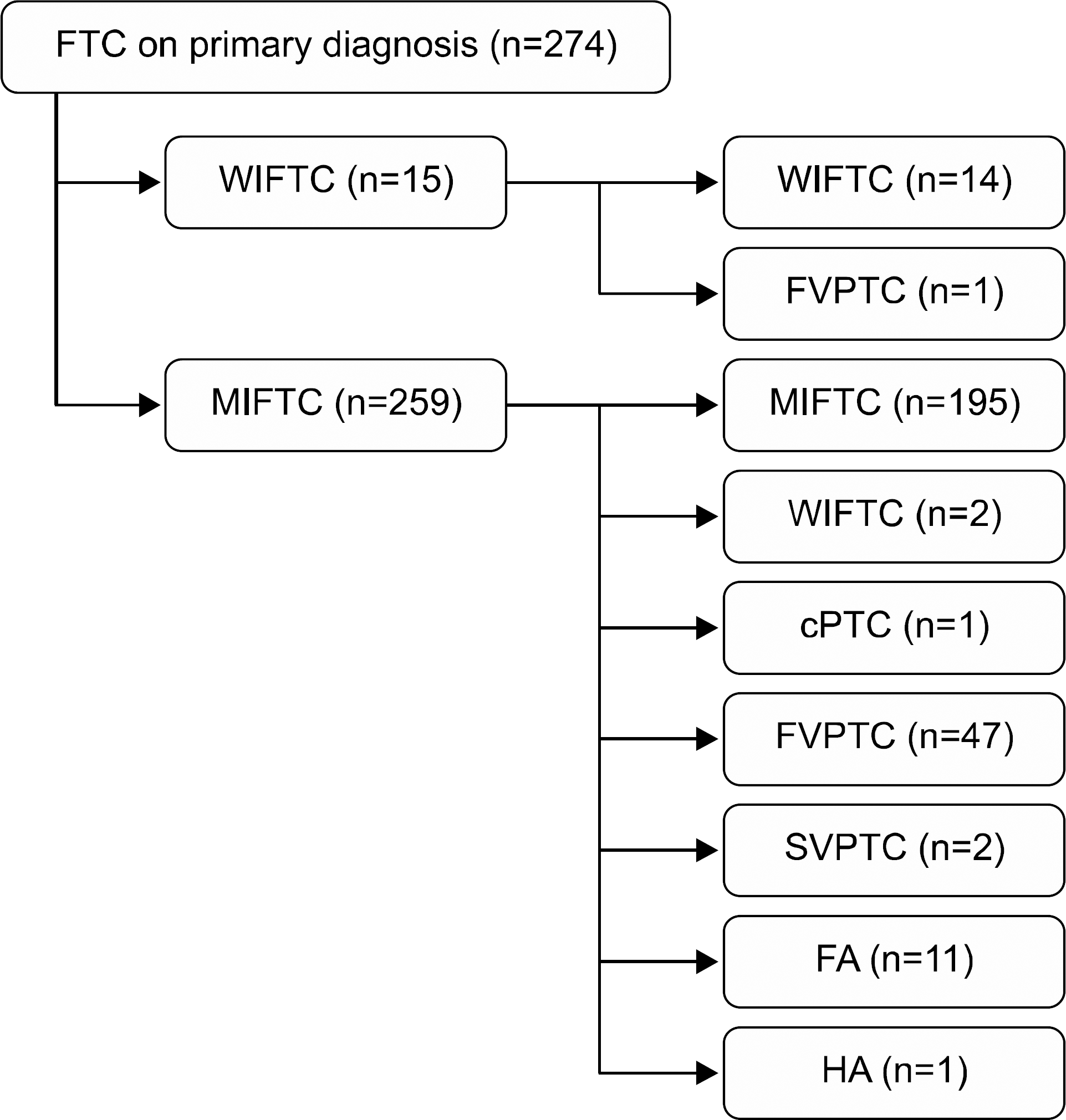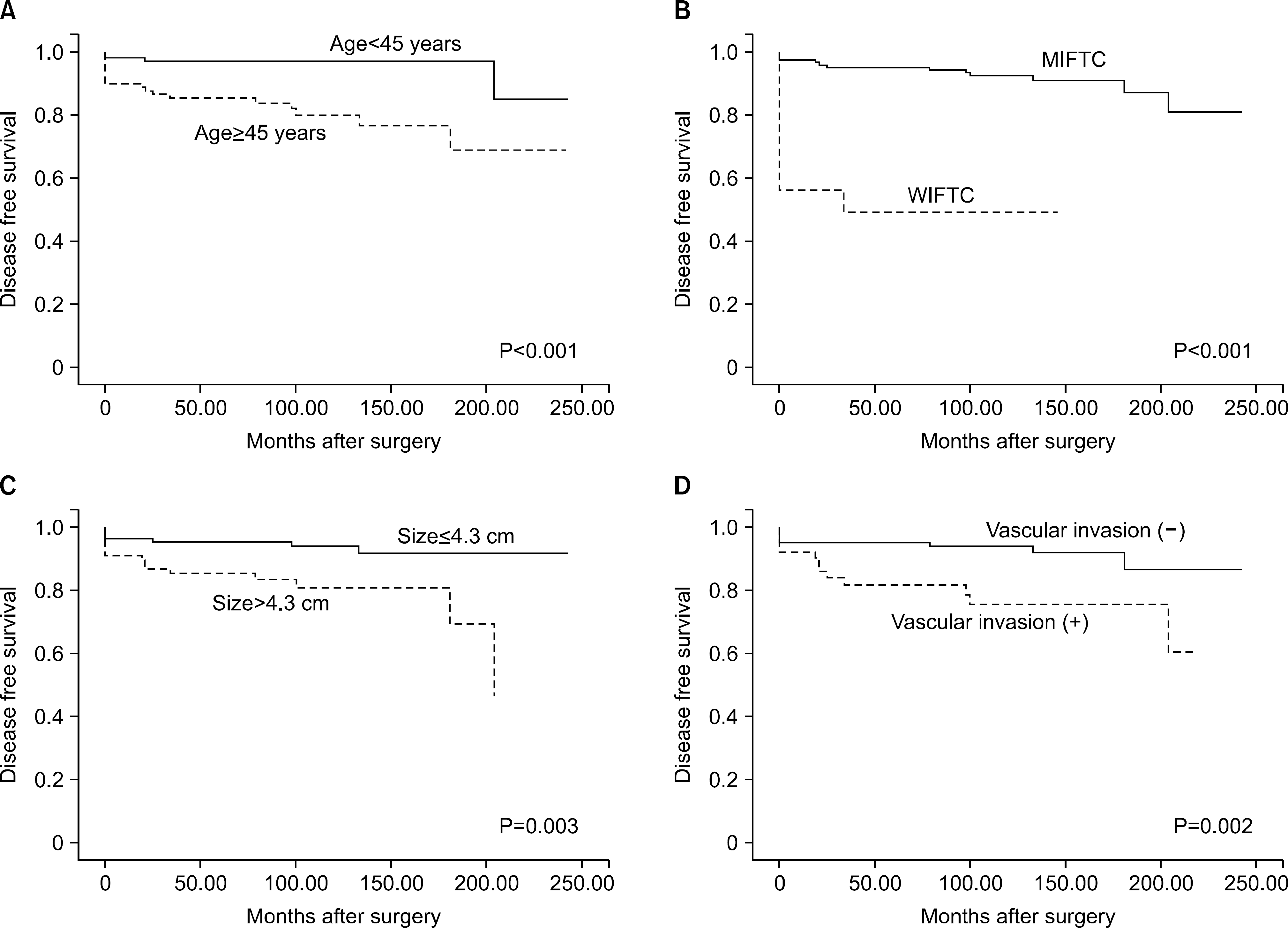Abstract
Purpose
The major issue of follicular thyroid carcinoma (FTC) diagnosed after hemithyroidectomy is whether to undergo further treatments. The aim of this study is to examine the clinicopathological characteristics of FTC and to evaluate the risk factors for distant metastasis.
Methods
From 1993 to 2010, 274 patients underwent initial thyroid surgery and were subsequently diagnosed as FTC. After review of the histological sections by an experienced pathologist, 211 patients were confirmed as FTC and were enrolled in this study. Clinicopathological features were compared based on the presence or absence of distant metastases, and the risk factors for distant metastases and distant metastases-free survival (DMFS) rates were analyzed.
Results
The patients included 39 males (18.5%) and 172 females (81.5%), with a mean age of 44.0±14.5 years. The median follow-up period was 99.5 months (range, 13.0∼222.0). Distant metastases were detected in 23 patients (10.9%), including 15 synchronous distant metastases and 8 metachronous distant metastases. In multivariate analysis, age ≥45 years, widely invasive FTC, tumor size ≥4.3 cm, and vascular invasion were independent risk factors for distant metastasis. DMFS rates in patients with these risk factors were significantly poorer than those in patients without these risk factors.
Go to : 
References
1. DeLellis R, Lloyd R, Heitz P, Eng C. WHO Classification of tumours. Pathology and genetics of tumours of endocrine organs. Lyon: IARC Press;2004. p. 73–6.
2. Lo CY, Chan WF, Lam KY, Wan KY. Follicular thyroid carcinoma: the role of histology and staging systems in predicting survival. Ann Surg. 2005; 242:708–15.
3. Ito Y, Hirokawa M, Higashiyama T, Takamura Y, Miya A, Kobayashi K, et al. Prognosis and prognostic factors of follicular carcinoma in Japan: importance of postoperative pathological examination. World J Surg. 2007; 31:1417–24.

4. Goffredo P, Cheung K, Roman SA, Sosa JA. Can minimally invasive follicular thyroid cancer be approached as a benign lesion?: a population-level analysis of survival among 1,200 patients. Ann Surg Oncol. 2013; 20:767–72.
5. Sugino K, Kameyama K, Nagahama M, Kitagawa W, Shibuya H, Ohkuwa K, et al. Does completion thyroidectomy improve the outcome of patients with minimally invasive follicular carcinoma of the thyroid? Ann Surg Oncol. 2014; 21:2981–6.

6. Ito Y, Miyauchi A, Tomoda C, Hirokawa M, Kobayashi K, Miya A. Prognostic significance of patient age in minimally and widely invasive follicular thyroid carcinoma: investigation of three age groups. Endocr J. 2014; 61:265–71.

7. Ban EJ, Andrabi A, Grodski S, Yeung M, McLean C, Serpell J. Follicular thyroid cancer: minimally invasive tumours can give rise to metastases. ANZ J Surg. 2012; 82:136–9.

8. Sugino K, Kameyama K, Ito K, Nagahama M, Kitagawa W, Shibuya H, et al. Outcomes and prognostic factors of 251 patients with minimally invasive follicular thyroid carcinoma. Thyroid. 2012; 22:798–804.

9. Delbridge L, Parkyn R, Philips J, Barraclough B, Robinson B. Minimally invasive follicular thyroid carcinoma: completion thyroidectomy or not? ANZ J Surg. 2002; 72:844–5.

10. O'Neill CJ, Vaughan L, Learoyd DL, Sidhu SB, Delbridge LW, Sywak MS. Management of follicular thyroid carcinoma should be individualised based on degree of capsular and vascular invasion. Eur J Surg Oncol. 2011; 37:181–5.
11. Ito Y, Hirokawa M, Masuoka H, Yabuta T, Kihara M, Higashiyama T, et al. Prognostic factors of minimally invasive follicular thyroid carcinoma: extensive vascular invasion significantly affects patient prognosis. Endocr J. 2013; 60:637–42.

12. D'Avanzo A, Treseler P, Ituarte PH, Wong M, Streja L, Greenspan FS, et al. Follicular thyroid carcinoma: histology and prognosis. Cancer. 2004; 100:1123–9.
13. Collini P, Sampietro G, Pilotti S. Extensive vascular invasion is a marker of risk of relapse in encapsulated non-Hürthle cell follicular carcinoma of the thyroid gland: a clinicopathological study of 18 consecutive cases from a single institution with a 11-year median follow-up. Histopathology. 2004; 44:35–9.
Go to : 
 | Fig. 1.The algorithm of selection for eligible patients in this study. All Hemotoxylin and eosin slides were reviewed by an experienced pathologist (DE Song). FA = follicular adenoma; cPTC = classical papillary thyroid carcinoma; FTC = follicular thyroid carcinoma; FVPTC = follicular variant papillary thyroid carcinoma; HA = Hurthle cell adenoma; SVPTC = solid variant papillary thyroid carcinoma; MIFTC = minimally thyroid carcinoma; WIFTC = widely invasive follicular thyroid carcinoma. |
 | Fig. 2.Distant metastasis free survival rates according to the independent risk factors. (A) Age, (B) histological classification, (C) primary tumor size, (D) the presence of vascular invasion. |
Table 1.
clinicopathological characteristics of patients with follicular thyroid carcinoma
| N=211 | N (%) |
|---|---|
| Sex | |
| Female | 172 (81.5) |
| Male | 39 (18.5) |
| Age (years) | |
| Mean±SD (range) | 44.01±14.45 (13∼78) |
| <45 | 112 (53.1) |
| ≥45 | 99 (46.9) |
| Surgical extent | |
| Hemithyroidectomy | 97 (46.0) |
| Total thyroidectomy | 114 (54.0) |
| Lymph node dissection | |
| No | 148 (70.1) |
| CCND | 63 (29.9) |
| Diagnosis | |
| Minimally invasive | 195 (92.4) |
| Widely invasive | 16 (7.6) |
| Tumor size (cm) | |
| Mean±SD (range) | 3.95±2.08 (0.5∼15) |
| Thyroiditis | |
| No | 195 (92.4) |
| Yes | 16 (7.6) |
| Extrathyroidal extension | |
| No | 154 (73.0) |
| Yes | 57 (27.0) |
| Vascular invasion | |
| No | 160 (75.8) |
| Yes | 51 (24.2) |
| RAI ablation* | |
| No | 6 (7.0)* |
| Yes | 108 (93.0)* |
| Distant metastasis | |
| No | 88 (89.1) |
| Yes | 23 (10.9) |
| Synchronous | 15 |
| Metachronous | 8 |
| Final status | |
| No evidence of disease | 188 (89.1) |
| Alive with disease | 13 (6.2) |
| Death | 10 (4.7) |
Table 2.
Univariate and multivariate analysis for distant metastasis in the patients with follicular thyroid carcinoma
| N=211 | NED 188 (89.1%) | Distant metastasis 23 (10.9%) |
Univariate |
Multivariate |
||
|---|---|---|---|---|---|---|
| Hazard ratio (95% CI) | P | Hazard ratio (95% CI) | P | |||
| Sex | ||||||
| Female | 156 (83.0) | 16 (69.6) | Ref. | |||
| Male | 32 (17.0) | 7 (30.4) | 2.4 (0.97∼5.93) | 0.075 | ||
| Age (years) | ||||||
| <45 | 108 (57.4) | 4 (17.4) | Ref. | Ref. | ||
| ≥45 | 80 (42.6) | 19 (82.6) | 5.79 (1.97∼17.02) | 0.001 | 3.5 (1.08∼11.36) | 0.037 |
| Surgical extent | ||||||
| Hemithyroidectomy | 94 (50.0) | 3 (13.0) | Ref. | Ref. | ||
| Total thyroidectomy | 94 (50.0) | 20 (87.0) | 5.61 (1.66∼18.9) | 0.005 | 2.74 (0.76∼9.91) | 0.125 |
| Lymph node dissection | ||||||
| No | 137 (72.9) | 11 (47.8) | Ref. | Ref. | ||
| CCND | 51 (27.1) | 12 (52.2) | 2.72 (1.2∼6.2) | 0.017 | 2.35 (0.83∼5.57) | 0.082 |
| Final pathologic diagnosis | ||||||
| Minimally invasive | 180 (95.7) | 15 (65.2) | Ref. | Ref. | ||
| Widely invasive | 8 (4.3) | 8 (34.8) | 11.27 (4.5∼28.19) | <0.001 | 3.11 (1.04∼9.32) | 0.043 |
| Tumor size (cm) | ||||||
| ≤4.3* | 126 (67.0) | 7 (30.4) | Ref. | Ref. | ||
| >4.3* | 62 (33.0) | 16 (69.6) | 4.31 (1.77∼10.5) | 0.001 | 3.56 (1.35∼9.36) | 0.01 |
| Thyroiditis | ||||||
| No | 172 (91.5) | 23 (100.0) | Ref. | |||
| Yes | 16 (8.5) | 0 (0) | 0.044 (0∼45.07) | 0.38 | ||
| Extrathyroidal extension | ||||||
| No | 137 (72.9) | 17 (73.9) | Ref. | |||
| Yes | 51 (27.1) | 6 (26.1) | 1.02 (0.4∼2.59) | 0.97 | ||
| Vascular invasion | ||||||
| No | 149 (79.3) | 11 (47.8) | Ref. | Ref. | ||
| Yes | 39 (20.7) | 12 (52.2) | 3.32 (1.46∼7.53) | 0.004 | 2.45 (1.05∼5.71) | 0.038 |
| RAI ablation | ||||||
| No | 98 (52.1) | 5 (21.7) | Ref. | Ref. | ||
| Yes | 90 (47.9) | 23 (78.3) | 3.43 (1.27∼9.27) | 0.015 | 2.56 (0.80∼8.94) | 0.088 |




 PDF
PDF ePub
ePub Citation
Citation Print
Print


 XML Download
XML Download